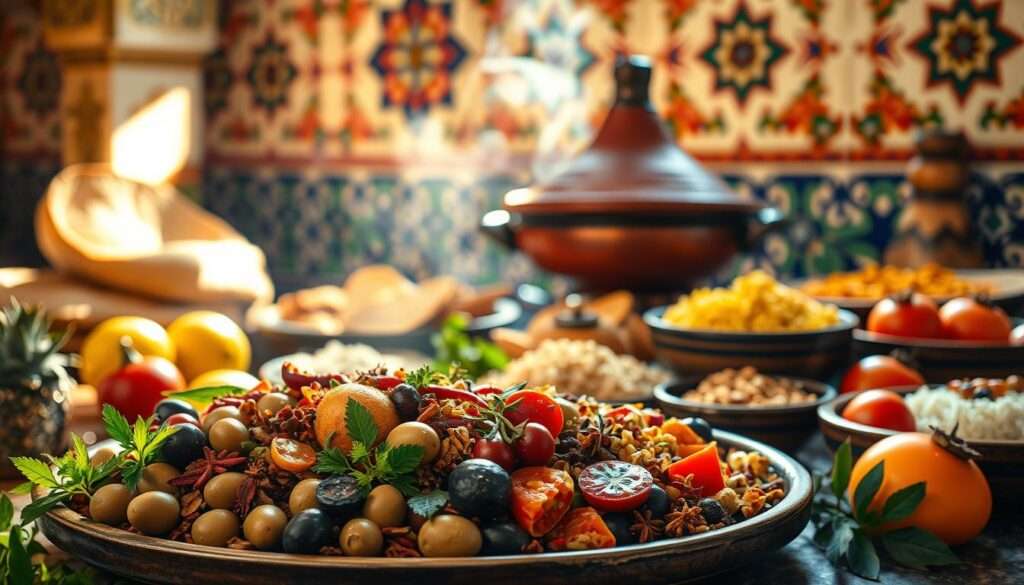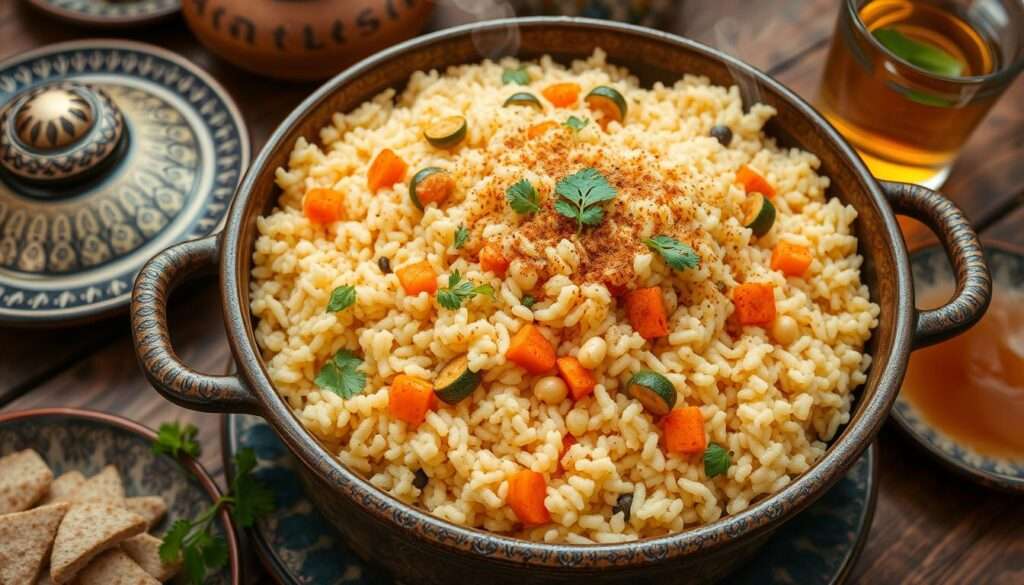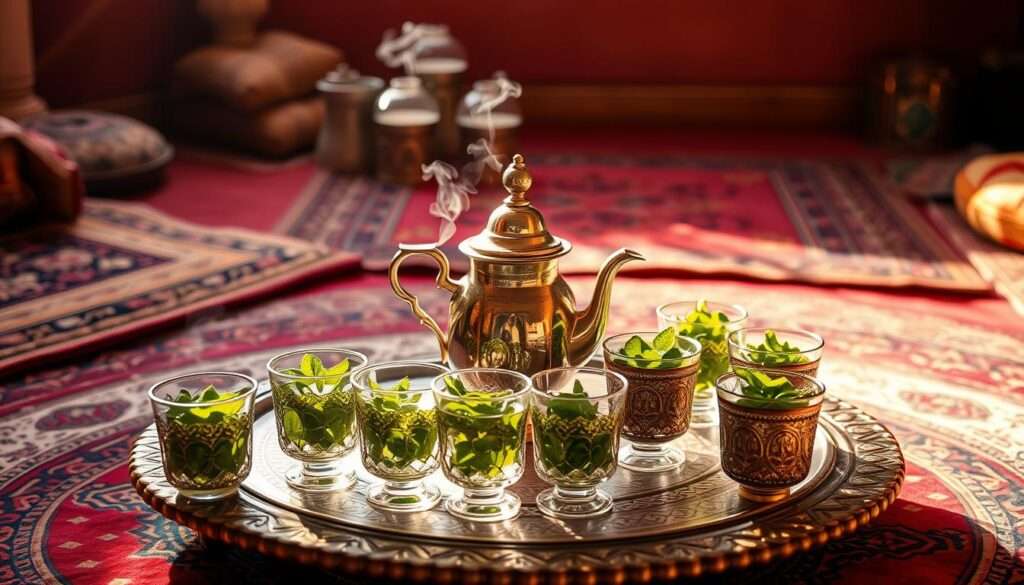Explore the Rich Tastes of Moroccan Cuisine
Discover the bold flavors of cuisine marocain, where centuries of history meet your taste buds. From the Mediterranean to the Sahara, Moroccan food blends North African cuisine traditions with spices like cumin, saffron, and paprika. Each dish tells a story of Berber, Arab, and Andalusian influences, creating meals that are as comforting as they are exotic.

Key Takeaways
- Traditional Moroccan dishes use slow-cooked techniques like tagine and couscous.
- Spices form the heart of Moroccan food, shaping both savory and sweet treats.
- Every meal reflects Morocco’s cultural crossings and natural landscapes.
- Recipes like cuisine marocain staples are adaptable for modern kitchens.
- From street snacks to ceremonial tea rituals, every bite has a story.
The Colorful Heritage of Moroccan Food Traditions
Moroccan food history is a rich tapestry of cultural exchange. It spans centuries, from Berber cuisine to Mediterranean influence. Each layer tells a story of adaptation and unity.
The Berber, Arab, and Mediterranean Influences
Berber traditions are at the heart of Moroccan cuisine. Nomadic tribes developed ways to preserve food like dried meats and slow-cooked stews. Arab traders introduced spices like saffron and cinnamon. Andalusian exiles brought intricate cooking techniques.
Mediterranean neighbors added olive oil and citrus. These elements mix in dishes like tagine with preserved lemons. This blend makes Moroccan food both familiar and exotic.
- Berber: Dried fruits, ghraiba sweets
- Arab: Cumin, coriander, and harissa
- Mediterranean: Olives, fish stews, and bastilla pastry
How Geography Shapes Moroccan Flavors
| Region | Key Ingredients | Signature Dishes |
|---|---|---|
| Coastal | Fish, lemons, olives | Fish tagine with cumin |
| Atlas Mountains | Lamb, potatoes, saffron | Kefta with harissa |
| Saharan South | Dates, dried fruits, couscous | Mint tea with almond sweets |
The Social Importance of Food in Moroccan Culture
A meal without guests is like a book without words.
Moroccan food is more than just food—it’s a social bond. Families come together for Friday couscous feasts. They share stories and bond over a communal platter.
Hospitality is key; refusing mint tea is seen as rude. Weddings feature bastilla, a pigeon pie that celebrates. Ramadan iftars bring communities together with dates and harira soup. These traditions make meals into moments of connection.
Essential Spices and Ingredients in “Cuisine Marocain”
A pantry of Moroccan spices shapes every dish. The legendary ras el hanout combines up to 30 spices, like turmeric and cloves, to season meats and couscous.
- Preserved lemons add a salty tang to tagines and salads.
- Argan oil drizzles over bread or couscous, offering a nutty finish.
“Every spice and ingredient carries Morocco’s history,” say culinary historians.
Other staples include cumin, saffron, and Moroccan ingredients like dates and almonds. Argan oil also stars in salads, while preserved lemons balance rich flavors. Store spices in cool, dark spots to keep their aroma vibrant. These essentials turn any kitchen into a gateway to North Africa’s flavors.
Tagine: The Iconic Clay Pot Cooking Method
The tagine’s cone-shaped pot changes how we cook. It uses slow, steam-infused cooking. This clay pot cooking method makes meats tender and spices blend well, creating dishes like lamb tagine or vegetable tagine. Every bite is filled with rich, layered flavors.
How a Tagine Works: Science Behind the Flavor
The pot’s narrow base and tapered lid trap steam. This steam circulates juices without needing extra liquid. The slow simmer, often taking 1.5–2 hours, tenderizes even tough cuts of meat. Modern kitchens use stovetops or ovens, but the principle remains the same: low heat, patience, and maximum flavor.
Popular Tagine Variations to Try
- Lamb tagine: Lamb shoulder slow-cooked with prunes, almonds, and cinnamon
- Chicken tagine: Chicken thighs paired with preserved lemons, olives, and saffron
- Vegetable tagine: Zucchini, eggplant, and tomatoes with cumin and paprika
Each variation showcases Morocco’s spice blends, balancing sweet and savory. These Moroccan tagine recipes use seasonal ingredients, making them perfect for any time of year.
Adapting Tagine Recipes for American Kitchens
If you don’t have a clay tagine, a Dutch oven works great. Just adjust cooking times by checking moisture every 30 minutes. For authentic taste, use dried fruits like apricots or raisins in lamb tagine dishes. Online resources like Moroccan tagine recipes from brands like Kalustyan’s spices can help with ingredient substitutions. Even a slow cooker can achieve the slow-cook effect on low heat.
Couscous: The Soul of Moroccan Friday Meals
Couscous is more than a dish—it’s a weekly celebration in Moroccan homes. Every Friday, families gather around steaming platters of Moroccan couscous. This tradition is rooted in centuries of shared history. The semolina-based grain holds a sacred place in Moroccan culture, symbolizing community and abundance.

Traditional Preparation Techniques
The art of traditional couscous preparation starts with hand-rolling semolina into tiny grains. This process, often done communally, contrasts with modern instant mixes. The couscous is then steamed in a double-pot couscoussier, capturing aromas from simmering vegetables and meats below.
The result? Light, fluffy grains that soak up every flavor.
Regional Couscous Variations
- Seven vegetable couscous from Marrakech blends carrots, turnips, and chickpeas.
- Coastal regions add fish or shrimp, while Fez versions mix caramelized onions and raisins.
- Desert couscous features dates and almonds, adapting to local harvests.
Nutritional Benefits of This Staple Grain
Couscous offers complex carbs for energy and fiber when made with whole grains. Pair it with lentils or chickpeas for protein. The vegetable-rich seven vegetable couscous ensures vitamin-rich balance.
Its couscous nutrition profile makes it a wholesome choice. It proves tradition meets modern health goals.
Sweet and Savory Pastries: From Bastilla to Briouats
At Moroccan celebrations, Moroccan pastries are the stars. The bastilla recipe is a highlight, with its crispy Moroccan phyllo pastry and tender chicken or pigeon. It’s spiced with saffron and cinnamon, topped with a creamy egg layer and toasted almonds.
This dish balances sweet and salty flavors. It comes from Andalusian roots, showing Morocco’s rich culture in its layers.
Briouat pastries are small but full of flavor. They’re crescent-shaped pockets filled with spiced beef, shrimp, or almond paste. Perfumed with orange blossom water, they’re fried until golden.
They’re great for casual gatherings or as appetizers. Here are a few more:
- M’hanncha: A spiral-shaped “snake pastry” stuffed with almonds and sesame
- Chebakia: Honey-drenched sesame coils, a Ramadan favorite
- Ghriba: Crumbly shortbread-like cookies with citrus zest
For home cooks, making savory pastries starts with handling phyllo dough. Keep it covered to prevent drying. Use cumin and paprika for savory fillings, and add sugar or dates for sweetness.
Moroccan cuisine is all about balance. Try adding honey to savory briouat for a twist.
These pastries show generosity and skill, reflecting community traditions. Whether making a big bastilla or small briouat, each fold tells a story of joy and heritage.
Mint Tea: Morocco’s Ceremony of Hospitality
Moroccan mint tea, or atai, is at the heart of Moroccan social life. It’s more than just a drink; it’s a symbol of tea hospitality that connects people. Every time it’s poured, it tells a story of warmth and connection.

The Art of Tea Preparation
Preparing atai is an art that requires precision. Start by steeping gunpowder tea leaves in boiling water. Add fresh mint and sugar, then pour the tea from a height to create a frothy layer. This process is repeated three times, each time revealing a different flavor.
- Rinse gunpowder tea leaves before steeping in boiling water.
- Add mint leaves and sugar to the pot.
- Pour the tea from a height of 12 inches to aerate it.
Cultural Significance and Serving Rituals
“Refusing tea is refusing friendship,” locals say.
The Moroccan tea ceremony is full of meaning. Silver teapots and colorful glasses symbolize abundance. Pouring from a distance creates a frothy layer, adding to the visual appeal. Guests must accept the first offer, as declining tea is seen as a sign of disrespect. This tradition strengthens social bonds and can last for hours.
Health Benefits of Moroccan Mint Tea
Gunpowder tea and mint together make a drink that’s good for you. While it’s traditionally sweet, you can make it less sweet without losing its health benefits:
- Supports digestion after meals
- Rich in antioxidants from green tea
- Mint’s calming menthol eases stress
Adjust the sugar to your liking while keeping its cultural value.
Street Food Delights: Exploring Morocco’s Urban Flavors
In the heart of Marrakech food stalls at Jemaa el-Fnaa market, the scent of sizzling msemen and charred almonds dances through the air. This UNESCO-listed square transforms at dusk into a sensory feast. Travelers can taste Morocco’s soul here. Flaky msemen—folded with honey, anise, or cheese—crackles under a charcoal grill. Vendors shout offers of Moroccan snacks like crispy harcha semolina cakes and deep-fried sfenj doughnuts.
Strolling through the stalls, visitors encounter regional specialties. Smoky snail stews in Marrakech, spicy merguez sausages in Fès, and fried sardines near Essaouira’s coast. The Moroccan street food scene thrives on spontaneity. Try a tangia-spiced meat sandwich from a donkey cart or a warm msemen wrapped in newsprint. Food safety tips? Look for busy stalls where dishes are freshly prepared.
- Msemen: Triple-layered pancakes brushed with argan oil
- Sfenj: Hole-riddled doughnuts dipped in honey
- Grilled m’smen: Bread stuffed with olives or preserved lemons
Bring this energy home: pan-fry msemen in a skillet, drizzle with local honey, and serve with mint tea. America’s kitchens can recreate these flavors using semolina flour and spice blends from Moroccan import shops. Whether savoring a buttery msemen in Jemaa el-Fnaa or replicating it in a Chicago apartment, these dishes embody Morocco’s communal dining spirit. Every bite connects to centuries of tradition.
Regional Specialties: From Coastal Seafood to Desert Cuisine
Morocco’s landscapes shape its flavors. From the Atlantic to the Sahara, regional Moroccan cuisine reflects tradition and adaptation.
Northern Coastal Delicacies
On the northern coast, Essaouira seafood is a highlight. Fishermen bring in sardines with preserved lemons and garlic. Chermoula-marinated fish tagines are flavored with paprika and cilantro.
In Tetouan, seafood bastilla combines mackerel with almond pastry and cinnamon sugar. It’s a mix of savory and sweet. Tangier’s markets are filled with olive-stuffed pastries, a tribute to Andalusian trade.
Central Atlas Mountain Foods
In the High Atlas, Atlas Mountain food shows the area’s rugged beauty. Marrakech’s tanjia cooks all night in clay urns. Shepherds roast mechoui lamb over fires.
Fez’s chefs take these traditions to new heights. They make Fez cuisine with walnut-stuffed mloukia soups and date-stuffed pancakes. Apricots from mountain orchards balance rich stews.
Southern Desert Cooking Traditions
South of the dunes, desert cooking turns scarcity into art. Berber cooks bury medfouna clay pots in hot sand. They bake a mix of spiced meats and lentils.
Dates sweeten every meal, from bsbousa pastries to camel-meat tagines. Nomadic tribes use goat’s milk and dried fruits to survive the arid climate.
Finding Authentic Moroccan Ingredients in America
Starting to make Moroccan recipes at home means finding the right ingredients. Many Moroccan grocery stores and online shops make this easy. Here’s how to get authentic flavors without leaving the country.
Best Specialty Stores and Online Resources
Check out Moroccan grocery stores in cities like New York, Los Angeles, or Washington D.C. for Moroccan spices and preserved lemons. Online, Moroccan Market or Spice Sheriff have import Moroccan food essentials. For authentic cooking tools, look for tagines and Moroccan cookware at Kalustyan’s or Sahadi’s.
- Buy Moroccan spices online from curated specialty sites
- Check Middle Eastern markets for hard-to find items
Suitable Substitutes for Hard-to Find Ingredients
Can’t find a key ingredient? Try these swaps:
| Ingredient | Substitute | How to Use |
|---|---|---|
| Preserved lemons | Preserved lemons substitute: homemade mix of fresh lemons, salt, and water | Soak for 2 weeks to soften bitterness |
| Ras el hanout | Blend cumin, cinnamon, and paprika | Adjust spice ratios to taste |
| Couscous | Steamed quinoa or pearl couscous | Fluff with a fork after cooking |
For Moroccan cookware, use a Dutch oven or slow cooker as a tagine alternative. Buy authentic items like argan oil online. But feel free to try substitutions for everyday dishes.
Conclusion: Embracing the Magic of Moroccan Cooking in Your Home
Moroccan cuisine is a mix of history and flavor, taking you on a journey with spices and traditions. It’s about enjoying the slow-cooked tagines and the colorful couscous platters. Start by trying a simple chicken tagine or adding ras el hanout to your meals. Modern Moroccan cooking makes it easy to enjoy, even without traditional clay pots.
Begin with trusted Moroccan cookbook recommendations like Paula Wolfert’s Couscous and Other Good Foods or explore modern takes in recent titles. Online Moroccan cooking classes can teach you how to shape couscous grains or balance harissa spice blends. Hosting a Moroccan dinner party? Pair dishes like bastilla with mint tea service—a ritual as vital as the food itself. Decorate with geometric patterns or lanterns, and play traditional Gnawa music for ambiance.
Authenticity blooms in curiosity, not perfection. Experiment with substitutions for hard-to-find ingredients, like using domestic mint for North African varieties. Each recipe tells a story of Berber ingenuity or Andalusian influence, waiting to be shared. As you cook, embrace the philosophy of patience and generosity woven into every meal. Moroccan food isn’t just flavors—it’s a bridge between cultures, served with the warmth of a host. Your kitchen becomes a gateway to a world where every spice choice honors a thousand years of tradition. Begin the journey today, one spoonful at a time.
FAQ
What are some must-try Moroccan dishes?
You should try tagines, couscous, and bastilla. Don’t miss out on mint tea, a key part of Moroccan culture!
How can I prepare Moroccan food at home?
Start by getting spices like ras el hanout, cumin, and cinnamon. Use them in dishes like chicken tagine or vegetable couscous for real Moroccan taste!
What is the significance of mint tea in Moroccan culture?
Mint tea is a sign of welcome. It’s served to guests, starting conversations and building connections.
How can I find Moroccan ingredients in the United States?
Look for Moroccan ingredients at stores like Kalustyan’s and Sahadi’s. You can also find them online. Check out shops that sell ras el hanout, preserved lemons, and tagine pots.
Are there vegetarian options in Moroccan cuisine?
Yes! Moroccan food has many vegetarian dishes. Try vegetable tagine, couscous with seven vegetables, and fresh herb salads.
What type of cookware do I need for Moroccan cooking?
An authentic tagine pot is best, but you can use a Dutch oven or slow cooker. Just adjust cooking times and methods.
What is ras el hanout and why is it important?
Ras el hanout is a spice blend with up to 30 spices. It’s key for Moroccan flavors, adding warmth and depth to dishes.
Can you explain the importance of communal eating in Moroccan culture?
In Morocco, meals are shared on large platters. This brings families together, showing the value of hospitality and togetherness.
What types of pastries are popular in Moroccan cuisine?
Moroccan pastries include sweet bastilla and briouats with nuts or meat. Chebakia, a honey-soaked cookie, is loved during Ramadan.
What unique ingredients define Moroccan cooking?
Moroccan cooking uses preserved lemons, argan oil, orange flower water, and dried fruits and nuts. These add special flavors and textures.

















